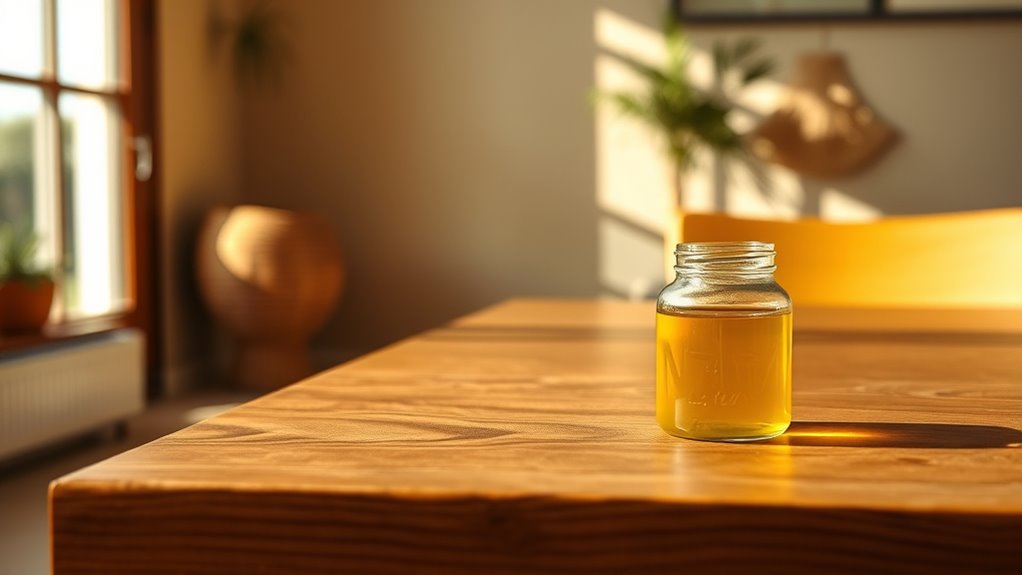Choosing eco-friendly finishes like low-VOC stains and natural oils improves your home’s indoor air quality and minimizes environmental harm. These options emit fewer harmful chemicals, are made from renewable resources, and support responsible forestry. Natural oils offer a beautiful, breathable finish that’s easy to maintain, while low-VOC stains reduce fumes during application. By opting for these sustainable choices, you promote healthier living spaces and contribute to environmental conservation—discover more ways to create a greener, healthier home.
Key Takeaways
- Low-VOC stains and natural oils reduce indoor air pollution, promoting healthier living environments.
- These finishes are derived from renewable resources and often carry certifications supporting sustainable sourcing.
- Natural oils offer a breathable, water-resistant finish that enhances wood’s natural beauty with minimal chemical emissions.
- Choosing eco-friendly finishes minimizes environmental impact and supports responsible forestry practices.
- Using these products demonstrates a commitment to sustainability, healthier homes, and environmentally responsible craftsmanship.

Choosing eco-friendly finishes is a smart way to reduce your environmental impact while enhancing the beauty and durability of your projects. When you opt for low-VOC stains and natural oils, you’re making a conscious decision to improve indoor air quality and support sustainable practices. These finishes emit fewer volatile organic compounds (VOCs), which are harmful chemicals that can off-gas into your home’s air, causing respiratory issues and other health problems. By prioritizing VOC reduction, you’re not only protecting your environment but also creating healthier living spaces for you and your loved ones.
Choosing eco-friendly finishes reduces environmental impact and improves indoor air quality.
Sustainable sourcing plays a critical role in choosing eco-friendly finishes. When you select products made from sustainably harvested materials, you’re supporting responsible forestry and reducing deforestation. Many natural oils and plant-based stains are derived from renewable resources, ensuring that your projects don’t contribute to environmental degradation. Look for finishes that have certifications or transparent sourcing information, so you know you’re making eco-conscious choices. This way, you’re promoting a healthier planet while achieving a beautiful, durable finish on your furniture, flooring, or cabinetry.
Using natural oils like linseed, tung, or hemp oil provides a beautiful, breathable finish that enhances the wood’s natural character. These oils penetrate deeply, offering water resistance and a warm, rich appearance without introducing harmful chemicals. Because they’re derived from plant-based sources, they tend to have lower VOC emissions, which benefits indoor air quality and reduces the need for long curing times. Natural oils are also easy to reapply or touch up, making them a practical choice for ongoing maintenance.
Low-VOC stains are another excellent option to think about. These products are formulated to emit minimal VOCs during application and curing, ensuring that you’re not inhaling toxic fumes. Many manufacturers now produce stains with plant-based solvents or water as a carrier, considerably decreasing harmful emissions. This not only makes the application process safer but also aligns with your commitment to sustainable sourcing. Plus, low-VOC stains often come in a variety of colors and finishes, allowing you to achieve the look you want without sacrificing eco-friendliness.
Incorporating eco-friendly finishes into your projects demonstrates a commitment to sustainability and health. By choosing low-VOC products made from sustainably sourced ingredients, you help reduce air pollution and conserve natural resources. These finishes deliver durability, beauty, and environmental benefits, making them an essential part of responsible craftsmanship. When you prioritize VOC reduction and sustainable sourcing, you’re not just finishing your projects—you’re contributing to a healthier planet and a healthier home. Additionally, understanding eco-friendly finishes can help you make more informed choices that align with your values.
Frequently Asked Questions
Are Low-Voc Stains as Durable as Traditional Finishes?
Yes, low-VOC stains can be just as durable as traditional finishes. They offer good chemical resistance and maintain color longevity when properly applied and maintained. Modern formulations have improved markedly, ensuring that eco-friendly options withstand daily wear and tear. You’ll find that these low-VOC stains provide a beautiful, lasting finish without sacrificing durability, making them a smart choice for healthy, stylish homes.
How Long Do Natural Oils Typically Last on Surfaces?
Natural oils typically last 1 to 3 years on surfaces, depending on exposure and maintenance. Their durability lifespan varies with factors like traffic and cleaning habits. To extend their longevity, you’ll need to reapply oil regularly and follow proper maintenance requirements. This proactive approach keeps your surfaces protected and looking great, ensuring the natural finish remains effective and vibrant for as long as possible.
Are Eco-Friendly Finishes Suitable for Outdoor Use?
You can definitely use eco-friendly finishes outdoors. For example, a homeowner applied a natural oil sealant to their wooden deck, noticing it resisted UV rays and prevented mold over the summer. These finishes often have good UV resistance, protecting surfaces from sun damage, and help prevent mold growth by reducing moisture retention. Just make certain you choose products specifically formulated for outdoor use to maximize durability and protection.
Do Natural Oils Require Special Application Techniques?
Yes, natural oils do require special application techniques. You should start with proper surface preparation, ensuring the wood is clean, dry, and sanded smooth. Apply the oils in thin, even coats using a brush or cloth, and allow each layer to absorb fully before adding another. This helps achieve a uniform finish and maximizes durability. Always follow manufacturer instructions for best results and to maintain the health benefits of eco-friendly finishes.
Can Eco-Friendly Finishes Be Easily Removed or Recoated?
Yes, eco-friendly finishes can be removed or recoated, but the process may vary. You might find the removal process easier with gentle methods, yet some natural oils can pose recoating challenges due to their absorption and curing times. Always follow manufacturer instructions to guarantee proper removal and reapplication. Regular maintenance and using compatible products help maintain the finish’s integrity and make recoating smoother.
Conclusion
By choosing low-VOC stains and natural oils, you’re sculpting a healthier home, much like an artist shaping a masterpiece with gentle, mindful strokes. You become the steward of your space, crafting an environment that’s as pure and vibrant as a forest untouched by pollution. Embrace these eco-friendly finishes, and let your home breathe freely—an oasis of harmony amid a world often clouded by toxins. Your conscious choices paint a brighter, healthier future for all who dwell within.









